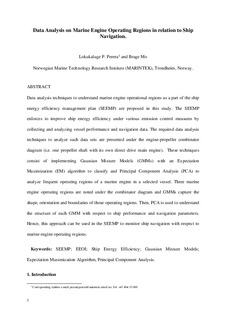| dc.contributor.author | Perera, Lokukaluge Prasad | |
| dc.contributor.author | Mo, Brage | |
| dc.date.accessioned | 2017-11-02T07:36:49Z | |
| dc.date.available | 2017-11-02T07:36:49Z | |
| dc.date.created | 2016-10-27T15:18:08Z | |
| dc.date.issued | 2016-12-01 | |
| dc.identifier.citation | Ocean Engineering. 2016, 128 163-172. | nb_NO |
| dc.identifier.issn | 0029-8018 | |
| dc.identifier.uri | http://hdl.handle.net/11250/2463572 | |
| dc.description.abstract | Data analysis techniques to understand marine engine operating regions as a part of the ship energy efficiency management plan (SEEMP) are proposed in this study. The SEEMP enforces to improve ship energy efficiency under various emission control measures by collecting and analyzing vessel performance and navigation data. The required data analysis techniques to analyze such data sets are presented under the engine-propeller combinator diagram (i.e. one propeller shaft with a direct drive main engine). These techniques consist of implementing Gaussian Mixture Models (GMMs) with an Expectation Maximization (EM) algorithm to classify and Principal Component Analysis (PCA) to analyze frequent operating regions of a marine engine in a selected vessel. Three marine engine operating regions are noted under the combinator diagram and GMMs capture the shape, orientation and boundaries of those operating regions. Then, PCA is used to understand the structure of each GMM with respect to ship performance and navigation parameters. Hence, this approach can be used in the SEEMP to monitor ship navigation with respect to marine engine operating regions. | nb_NO |
| dc.language.iso | eng | nb_NO |
| dc.rights | Navngivelse-Ikkekommersiell-DelPåSammeVilkår 4.0 Internasjonal | * |
| dc.rights.uri | http://creativecommons.org/licenses/by-nc-sa/4.0/deed.no | * |
| dc.subject | SEEMP | nb_NO |
| dc.subject | EEOI | nb_NO |
| dc.subject | Ship energy efficiency | nb_NO |
| dc.subject | Gaussian Mixture Models | nb_NO |
| dc.subject | Expectation Maximization algorithm | nb_NO |
| dc.subject | Principal Component Analysis | nb_NO |
| dc.title | Data analysis on marine engine operating regions in relation to ship navigation | nb_NO |
| dc.type | Journal article | nb_NO |
| dc.type | Peer reviewed | nb_NO |
| dc.description.version | acceptedVersion | nb_NO |
| dc.source.pagenumber | 163-172 | nb_NO |
| dc.source.volume | 128 | nb_NO |
| dc.source.journal | Ocean Engineering | nb_NO |
| dc.identifier.doi | 10.1016/j.oceaneng.2016.10.029 | |
| dc.identifier.cristin | 1395165 | |
| dc.relation.project | Norges forskningsråd: 237917 | nb_NO |
| cristin.unitcode | 7566,7,0,0 | |
| cristin.unitname | Maritim | |
| cristin.ispublished | true | |
| cristin.fulltext | postprint | |
| cristin.qualitycode | 1 | |

